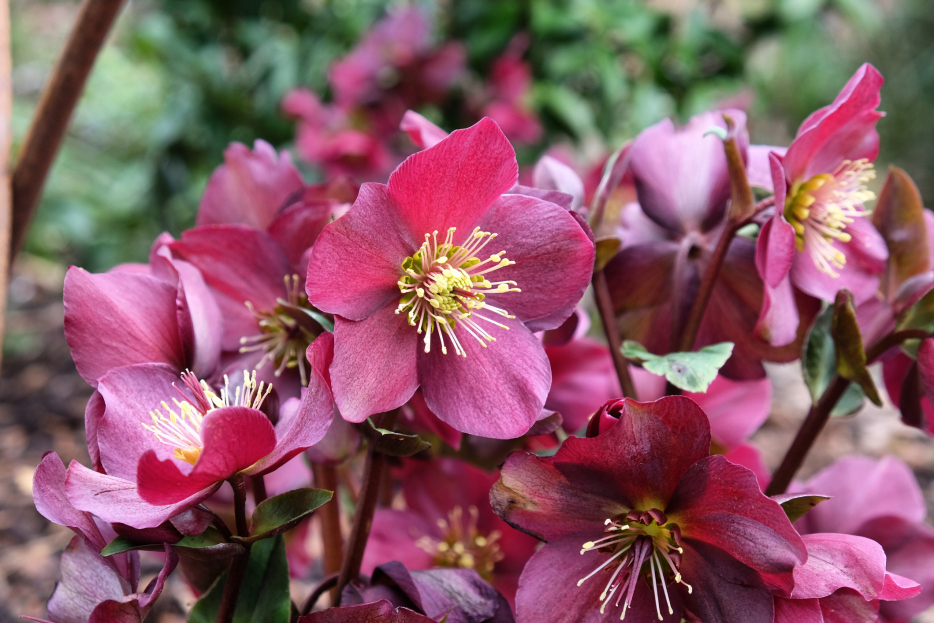
Helleborus, commonly known as Lenten Rose, is a stunning perennial plant that blooms in late winter to early spring, often when most other plants are still dormant. Known for its beautiful, nodding flowers in shades of white, pink, purple, and green, Helleborus is a favorite among gardeners who want to add early-season color to their landscapes. Whether you’re growing it in your garden or as a houseplant, this resilient plant can thrive with the right care. Here’s a comprehensive guide on how to care for your Helleborus.
Helleborus prefers partial shade or dappled sunlight. In its natural habitat, it often grows under the canopy of trees, so it thrives in environments that mimic these conditions. Too much direct sunlight can scorch the leaves, causing them to turn yellow or brown, so it’s important to find a location with some protection from the harsh midday sun.
If you’re growing Helleborus indoors, place it near a window that gets bright, indirect light. A north or east-facing window is ideal. If you can’t provide enough natural light, you can supplement with a grow light to ensure the plant gets the right amount of light for healthy growth.
Helleborus thrives in well-draining, rich, loamy soil. The plant prefers slightly acidic to neutral soil (pH between 6.0 and 7.0). Before planting, enrich the soil with organic matter, such as compost or well-rotted manure, to improve drainage and provide essential nutrients.
Good drainage is key to preventing root rot, so if your soil tends to retain too much moisture, you can amend it with sand or perlite to enhance drainage. When growing Helleborus in a container, ensure the pot has drainage holes and use a high-quality potting mix with added organic material.
Helleborus is relatively drought-tolerant once established, but it still requires regular watering, especially during dry periods. The key is to keep the soil consistently moist but not soggy. Overwatering can lead to root rot, so it’s essential to ensure that the soil drains well.
Water your Helleborus when the top inch of soil feels dry to the touch. During the growing season, you may need to water more frequently, but be sure to let the soil dry out slightly between waterings. In the winter, when the plant is dormant, reduce watering to avoid excess moisture.
If you’re growing Helleborus in a container, be extra cautious with watering, as pots can dry out faster than garden beds. Ensure the plant is not sitting in water by emptying the saucer regularly.
Helleborus is a cold-hardy plant that thrives in cool temperatures. It can tolerate temperatures as low as -10°F (-23°C) once established, making it ideal for colder climates. However, it prefers moderate temperatures between 40°F and 60°F (4°C to 16°C), especially during the growing season.
Helleborus is also relatively tolerant of humidity, as it naturally grows in woodland environments where humidity levels tend to be moderate. If you’re growing it indoors, it should do well in typical household humidity levels, but if you live in a particularly dry climate, you may want to occasionally mist the leaves or place a humidity tray near the plant.
Helleborus is a low-maintenance plant that doesn’t require frequent fertilization. However, to encourage healthy growth and vibrant blooms, you can fertilize it once or twice a year with a balanced, slow-release fertilizer. Apply the fertilizer in early spring, just as the plant begins to emerge from dormancy, and again in late summer if needed.
Avoid fertilizing too often, as this can lead to lush foliage growth at the expense of flowers. Organic fertilizers, such as compost or well-rotted manure, are also great options to feed the plant naturally.
Pruning is an important part of maintaining a healthy and attractive Helleborus. After the plant finishes blooming in late spring, you can cut back the spent flowers to the base of the plant. This will encourage new growth and prevent the plant from putting energy into producing seeds.
In the fall, it’s also a good idea to remove any dead or damaged foliage to keep the plant tidy. However, avoid cutting back all the leaves, as the foliage provides important protection for the roots during the winter months.
Helleborus is generally a pest-resistant plant, but it can occasionally be susceptible to aphids, slugs, or snails. If you notice pests, treat the plant with insecticidal soap or neem oil, or hand-pick the pests off the leaves.
One common issue with Helleborus is root rot, which is often caused by overwatering or poorly-draining soil. Ensure that the plant is in a well-drained location and avoid letting it sit in water.
If the leaves begin to turn yellow or show signs of wilting, it could be a sign of too much moisture or a nutrient deficiency. Ensure the soil is well-draining, and consider adding compost or organic matter to improve soil quality.
Helleborus can be propagated by dividing the plant in early spring or late fall. To divide, carefully dig up the plant and separate the root ball into smaller sections, each with at least one growing point. Replant the divisions in well-prepared soil, and water them thoroughly.
Helleborus can also be propagated from seed, though this process takes longer and requires patience. Sow the seeds in a cold frame or a sheltered outdoor area, and allow them to germinate over the course of several months. It may take 1-2 years before the plants are large enough to bloom.
Yes, Helleborus is toxic to pets if ingested. The plant contains saponins, which can cause vomiting, diarrhea, and other digestive issues in both cats and dogs. It’s best to keep Helleborus out of reach of pets, especially if they tend to nibble on plants.